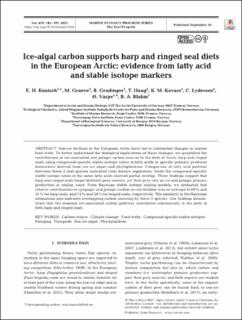| dc.contributor.author | Kunisch, Erin | |
| dc.contributor.author | Graeve, Martin | |
| dc.contributor.author | Gradinger, Rolf | |
| dc.contributor.author | Haug, Tore | |
| dc.contributor.author | Kovacs, Kit M. | |
| dc.contributor.author | Lydersen, Christian | |
| dc.contributor.author | Varpe, Øystein Heggernes | |
| dc.contributor.author | Bluhm, Bodil | |
| dc.date.accessioned | 2021-11-04T12:48:43Z | |
| dc.date.available | 2021-11-04T12:48:43Z | |
| dc.date.created | 2021-10-26T17:22:43Z | |
| dc.date.issued | 2021 | |
| dc.identifier.citation | Marine Ecology Progress Series. 2021, 675 181-197. | |
| dc.identifier.issn | 0171-8630 | |
| dc.identifier.uri | https://hdl.handle.net/11250/2827907 | |
| dc.description.abstract | Sea-ice declines in the European Arctic have led to substantial changes in marine food webs. To better understand the biological implications of these changes, we quantified the contributions of ice-associated and pelagic carbon sources to the diets of Arctic harp and ringed seals using compound-specific stable isotope ratios of fatty acids in specific primary producer biomarkers derived from sea-ice algae and phytoplankton. Comparison of fatty acid patterns between these 2 seal species indicated clear dietary separation, while the compound-specific stable isotope ratios of the same fatty acids showed partial overlap. These findings suggest that harp and ringed seals target different prey sources, yet their prey rely on ice and pelagic primary production in similar ways. From Bayesian stable isotope mixing models, we estimated that relative contributions of sympagic and pelagic carbon in seal blubber was an average of 69% and 31% for harp seals, and 72% and 28% for ringed seals, respectively. The similarity in the Bayesian estimations also indicates overlapping carbon sourcing by these 2 species. Our findings demonstrate that the seasonal ice-associated carbon pathway contributes substantially to the diets of both harp and ringed seals. | |
| dc.language.iso | eng | |
| dc.subject | Klimaendringer | |
| dc.subject | Climate change | |
| dc.subject | Sel | |
| dc.subject | Pinnipeds | |
| dc.subject | Fytoplankton | |
| dc.subject | Phytoplankton | |
| dc.subject | Alger | |
| dc.subject | Algae | |
| dc.title | Ice-algal carbon supports harp and ringed seal diets in the European Arctic: evidence from fatty acid and stable isotope markers | |
| dc.type | Peer reviewed | |
| dc.type | Journal article | |
| dc.description.version | publishedVersion | |
| dc.subject.nsi | VDP::Marinbiologi: 497 | |
| dc.subject.nsi | VDP::Marine biology: 497 | |
| dc.source.pagenumber | 181-197 | |
| dc.source.volume | 675 | |
| dc.source.journal | Marine Ecology Progress Series | |
| dc.identifier.doi | 10.3354/meps13834 | |
| dc.identifier.cristin | 1948631 | |
| dc.relation.project | Norges forskningsråd: 244319 | |
| cristin.ispublished | true | |
| cristin.fulltext | original | |
| cristin.qualitycode | 2 | |
